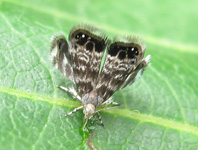Abstract
New deep-sea nematodes of the family Microlaimidae are described from the Southwest Pacific Ocean and Ross Sea. Microlaimus korari n. sp. is characterised by annulated cuticle with longitudinal bars, round amphideal aperture slightly smaller than the cryptospiral amphideal fovea, spacious and heavily cuticularised buccal cavity with large dorsal tooth and right subventral tooth situated anteriorly relative to left subventral tooth, slender spicules 4.4 cloacal body diameters long, and gubernaculum 1.2 cloacal body diameters long with laterally curved distal end and swollen proximal end. Bolbolaimus tongaensis n. sp. is characterised by annulated cuticle with longitudinal bars, oval amphideal aperture and cryptocircular amphideal fovea situated between cephalic setae and only partially surrounded by cuticle annulations, and short spicules cuticularised along dorsal edge and at proximal end and with swollen portion near proximal end. Maragnopsia n. gen. is characterised by a minute, non-cuticularised mouth cavity without teeth, an elongated posterior pharyngeal bulb more than twice as long as it is wide, a single outstretched testis, and a conico-cylindrical tail 13–16 anal body diameters long. A list of all 83 valid Microlaimus species is provided. The present study provides the first microlaimid species records from deep-sea habitats (> 200 m depth) in the Southwest Pacific and Ross Sea. The presence of M. korari n. sp. on both the continental slope of New Zealand and Ross Sea abyssal plain suggests that this species has a wide geographical and depth distribution. However, molecular analyses will be required to confirm the identity of these two geographically disparate populations.
References
Cobb, N.A. (1920) One hundred new nemas (types species of 100 new genera). Contributions to the Science of Nematology, 9, 217–343.
Gambi, C., Vanreusel, A. & Danovaro, R. (2008) Biodiversity of nematode assemblages from deep-sea sediments of the Atacama Slope and Trench (South Pacific Ocean). Deep-Sea Research I, 50, 103–117.
http://dx.doi.org/10.1016/S0967-0637(02)00143-7Gerlach, S.A. (1957) Marine Nematoden aus dem Mangrove-Gebiet von Cananéia (Brasilianische Meeres-Nematoden III). Abhandlungen der Mathematisch-Naturwissenschaftlichen Klasse, Akademie der Wissenschaften und der Literatur, 5, 129–176.
Giere, O. (2009) Meiobenthology. The microscopic motile fauna of aquatic sediments. 2nd Edition. Springer, Berlin Heidelberg, 527 pp.
Jensen, P. (1978) Revision of Microlaimidae, erection of Molgolaimidae fam. n., and remarks on the systematic position of Paramicrolaimus (nematode, Desmodorida). Zoologica Scripta, 7, 159–173.
http://dx.doi.org/10.1111/j.1463-6409.1978.tb00599.xJensen, P. (1989) Redescription of Microlaimus capillaris Gerlach, 1957 (Nematoda, Chromadorida) from a mangrove mud-flat in NSW, Australia. Hydrobiologia, 171, 259–262.
http://dx.doi.org/10.1007/BF00008148Kovalyev, S.V. & Tchesunov, A.V. (2005) Taxonomic review of microlaimids with description of five species from the White Sea (Nematoda: Chromadoria). Zoosystematica Rossica, 14, 1–16.
Kovalyev, S.V. & Miljutina, M.A. (2009) A review of the genus Aponema Jensen, 1978 (Nematoda: Microlaimidae) with description of three new species. Zootaxa, 2077, 56–68.
Leduc, D. & Verschelde, D. (2015) New Spirinia and Stygodesmodora species (Nematoda, Spiriniinae) from the Southwest pacific, and a revision of the related genera Spirinia, Chromaspirina, and Perspiria. European Journal of Taxonomy, 118, 1–25.
http://dx.doi.org/10.5852/ejt.2015.118Lorenzen, S. (1976) Desmodoridae (Nematoden) mit extrem langen spicula aus Südamerika. Mitteilungen aus dem Instituto Colombo-Alemán Invest Cient, 8, 63–78.
Miljutin, D.M. & Miljutina, M.A. (2009) Deep-sea nematodes of the family Microlaimidae from the Clarion-Clipperton Fractre Zone (North-Eastern Tropic Pacific), with the description of three new species. Zootaxa, 2096, 137–172.
Miljutin, D.M., Gad, Gunnar., Miljutina, M.M., Mokievsky, V.O., Fonseca-Genevois, V. & Esteves, A.M. (2010) The state of knowledge on deep-sea nematode taxonomy: how many valid species are known down there? Marine Biodiversity, 40, 143–159.
http://dx.doi.org/10.1007/s12526-010-0041-4Muthumbi, A., Verschelde, D. & Vincx, M. (1995) New Desmodoridae (Nematoda: Desmodoroidea): three new species from Ceriops mangrove sediments (Kenya) and one related new species from the North Sea. Cahiers de Biologie Marine, 36, 181–195.
Platt, H.M. & Warwick, R.M. (1988) Free-living Marine Nematodes Part II, British Chromadorids. In: Kermack, D.M. & Barnes, R.S.K. (Eds.), Synopses of the British Fauna, New Series, No. 38, pp. 1–502.
Somerfield, P.J. & Warwick, R.M. (1996) Meiofauna in Marine Pollution Monitoring Programmes: A Laboratory Manual. Ministry of Agriculture, Fisheries and Food, Lowestoft, 71 pp.
Tchesunov, A.V. (2014) Order Desmodorida De Coninck, 1965. In: Shmidt-Rhaesa, A. (Ed.), Handbook of Zoology Gastrotricha, Cyclioneura and Gnathifera. Vol. 2. Nematoda. De Gruyter, Hamburg, pp. 399−434.
Tietjen, J.H. (1989) Ecology of deep-sea nematodes from the Puerto Rico Trench area and Hatteras Abyssal Plain. Deep-Sea Research, 36, 1579−1594.
http://dx.doi.org/10.1016/0198-0149(89)90059-9Verschelde, D., Gourbault, N. & Vincx, M. (1998) Revision of Desmodora with descriptions of new desmodorids (Nematoda) from hydrothermal vents of the Pacific. Journal of the Marine Biological Association of the United Kingdom, 78, 75−112.

